|
|
Created by Noushi 9
over 9 years ago
|
|
Rate this resource by clicking on the stars below:




 (1)
(1)
Ratings (1)
| 1 | ||
| 0 | ||
| 0 | ||
| 0 | ||
| 0 |
0 comments
There are no comments, be the first and leave one below:
Close
4966012
note
2016-09-21T00:31:35Z
2/5
Section 2
a) organelles - cells - tissues - organs - systems - (organism)
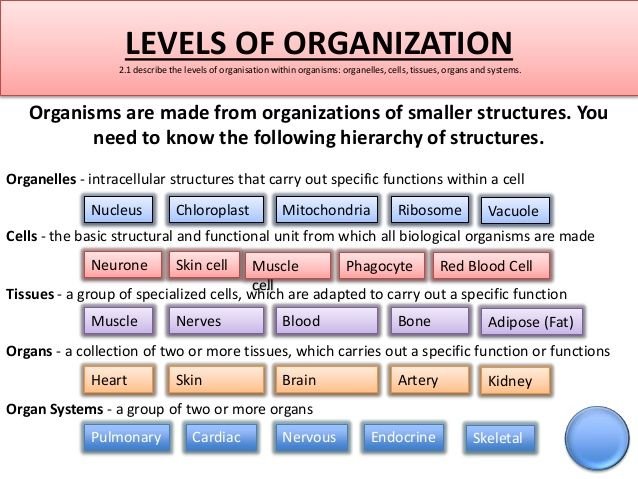
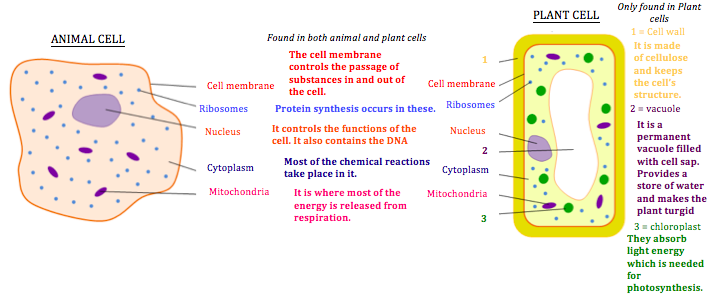
c) Biological molecules
Carbs = C,H,O
Proteins = C,H,O,N
Lipids = C,H,O
Carbs (starch or glycogen) - made from simple sugars (glucose & fructose)
Proteins - made from amino acids
Lipis - made from 1 glycerol molecule + 3 fatty acid molecules
Carbs = C,H,O
Proteins = C,H,O,N
Lipids = C,H,O
Carbs (starch or glycogen) - made from simple sugars (glucose & fructose)
Proteins - made from amino acids
Lipis - made from 1 glycerol molecule + 3 fatty acid molecules
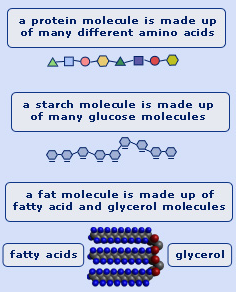
Tests
Glucose - 4cm3 of sample + 1cm3 of Benedict's Solution in a test tube
Heat in a water bath at 50C for 2-3 mins
Turns light blue to brick red
Starch - 5cm3 of sample in a test tube
Add drops of Iodine solution
Turns golden brown to blue/black
Low temperature = Inactive enzyme. Substrate and enzyme collide less often
Optimum temperature = Lots of kinetic energy, colliding more and enzyme is most active
Over optimum temperature = Active site shape changes. No longer complementary to substrate. Enzyme denatures
pH - As it changes (high or low) the shape of the active site also changes ∴ less collisions successful
Experiment
Glucose - 4cm3 of sample + 1cm3 of Benedict's Solution in a test tube
Heat in a water bath at 50C for 2-3 mins
Turns light blue to brick red
Starch - 5cm3 of sample in a test tube
Add drops of Iodine solution
Turns golden brown to blue/black
Low temperature = Inactive enzyme. Substrate and enzyme collide less often
Optimum temperature = Lots of kinetic energy, colliding more and enzyme is most active
Over optimum temperature = Active site shape changes. No longer complementary to substrate. Enzyme denatures
pH - As it changes (high or low) the shape of the active site also changes ∴ less collisions successful
Experiment
- Place separate boiling tubes with fixed volumes of starch and amylase into different temperature water baths
- Wait 5 mins for solutions to reach temperature
- Mix the starch and amylase and immediately do step 4
- Every 1 min transfer a small sample using a pipette into a spotting tile well and add iodine solution. Will immediately turn blue/black
- Record colour. When the iodine turns golden brown no starch is present because all the starch has been digested by enzymes.
- Compare results to see at which temperature the iodine turned golden brown first. Rate = volume of starch/time taken to go golden brown
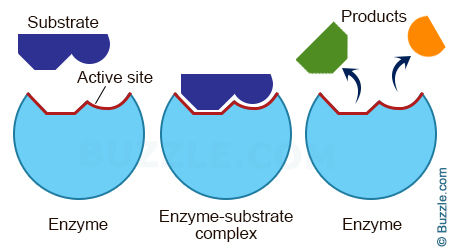
d) Osmosis, diffusion, active transport
Rate affected by SA:V ratio, temperature and concentration gradient
Plants cells are usually turgid because the cell wall is much stronger than the cell membrane. It keeps leaves firm and plant upright if it has no wood
Plant cells can plasmolyse & Animal cells can shrivel
Think : Hyper = lose energy = lose water
Remember - Iso/Hypo/Hyper tonic to the cell
Rate affected by SA:V ratio, temperature and concentration gradient
Plants cells are usually turgid because the cell wall is much stronger than the cell membrane. It keeps leaves firm and plant upright if it has no wood
Plant cells can plasmolyse & Animal cells can shrivel
Think : Hyper = lose energy = lose water
Remember - Iso/Hypo/Hyper tonic to the cell
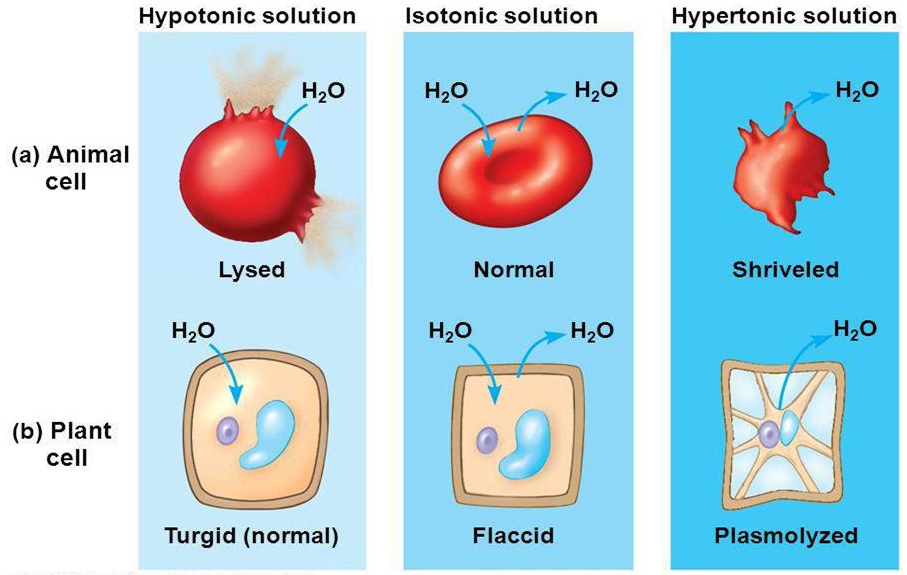
e) Nutrition
Flowering Plants
magnesium ions - for chlorophyll
nitrate ions - for amino acids (to make protein)
Hydrogencarbonate indicator:
Yellow = High CO2
Orange = Normal CO2
Purple = Low CO2
Flowering Plants
magnesium ions - for chlorophyll
nitrate ions - for amino acids (to make protein)
Hydrogencarbonate indicator:
Yellow = High CO2
Orange = Normal CO2
Purple = Low CO2
h) Transport
Flowering Plants
Xylem - Water and minerals
Phloem - Sucrose and amino acids
More light so stomata open, so more water is lost
Humans
Hepatic artery/vein = Liver
Hepatic portal vein = Digestive system to liver
Renal artery/vein = Kidney
Pulmonary circuit - Heart to lungs
Systemic circuit - Heart to body
Double circulatory system: More efficient
Allows higher levels of activity as oxygen + glucose can be pumped to muscle cells quicker
Respiration needs to take place quickly to maintain body temperature of 37C
Single cell organisms have a high SA:V ratio so can supply the demand
Multicellular organisms have a low SA:V ratio. & skin does not allow much diffusion
Flowering Plants
Xylem - Water and minerals
Phloem - Sucrose and amino acids
More light so stomata open, so more water is lost
Humans
Hepatic artery/vein = Liver
Hepatic portal vein = Digestive system to liver
Renal artery/vein = Kidney
Pulmonary circuit - Heart to lungs
Systemic circuit - Heart to body
Double circulatory system: More efficient
Allows higher levels of activity as oxygen + glucose can be pumped to muscle cells quicker
Respiration needs to take place quickly to maintain body temperature of 37C
Single cell organisms have a high SA:V ratio so can supply the demand
Multicellular organisms have a low SA:V ratio. & skin does not allow much diffusion
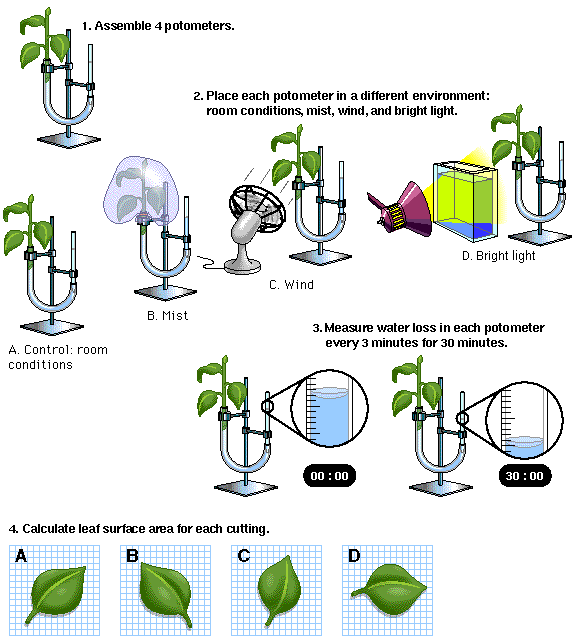
i) Excretion
Flowering Plants
Excrete O2 and CO2 through stomata
Humans
The Kidney carries out excretion AND osmoregulation
Ultrafiltration in glomerulus. Glomerular filtarte is what gets past into the Bowman's Capsule
Selective reabsorption (uses active transport) in proximal convoluted tubule of glucose,amino acids and some water
Urine contains water,urea and salts
Negative feedback. ↓Little water - ↑ADH - Collecting duct permeability↑ - ↑ water reabsorbed in blood
Urinary system = Kidneys → Ureters → Bladder → Urethra
Flowering Plants
Excrete O2 and CO2 through stomata
Humans
The Kidney carries out excretion AND osmoregulation
Ultrafiltration in glomerulus. Glomerular filtarte is what gets past into the Bowman's Capsule
Selective reabsorption (uses active transport) in proximal convoluted tubule of glucose,amino acids and some water
Urine contains water,urea and salts
Negative feedback. ↓Little water - ↑ADH - Collecting duct permeability↑ - ↑ water reabsorbed in blood
Urinary system = Kidneys → Ureters → Bladder → Urethra
j) Co-ordination and response
Flowering Plants
Photo,Geo,Hydro tropism. +ve = towards, -ve = away the direction of stimulus.
Humans
Stimulis → receptor → coordination → effector → response
Accommodation - Focusing of the lens by the changing of its shape. (depending on object's distance)
First think of what the suspensor ligaments do (contract or relax), then remember the ciliary muscles do the opposite
ADH - Pituitary gland, permeability of collecting duct
Insulin/Glucagon - Pancreas. Change blood glucose level
Adrenaline - Adrenal glands. Fight or flight
Oestrogen/Progesterone - Ovaries. Regulates menstrual cycle/Secondary sexual characteristics
Testosterone - Testes. Secondary sexual characteristics
Flowering Plants
Photo,Geo,Hydro tropism. +ve = towards, -ve = away the direction of stimulus.
Humans
Stimulis → receptor → coordination → effector → response
Accommodation - Focusing of the lens by the changing of its shape. (depending on object's distance)
First think of what the suspensor ligaments do (contract or relax), then remember the ciliary muscles do the opposite
ADH - Pituitary gland, permeability of collecting duct
Insulin/Glucagon - Pancreas. Change blood glucose level
Adrenaline - Adrenal glands. Fight or flight
Oestrogen/Progesterone - Ovaries. Regulates menstrual cycle/Secondary sexual characteristics
Testosterone - Testes. Secondary sexual characteristics


